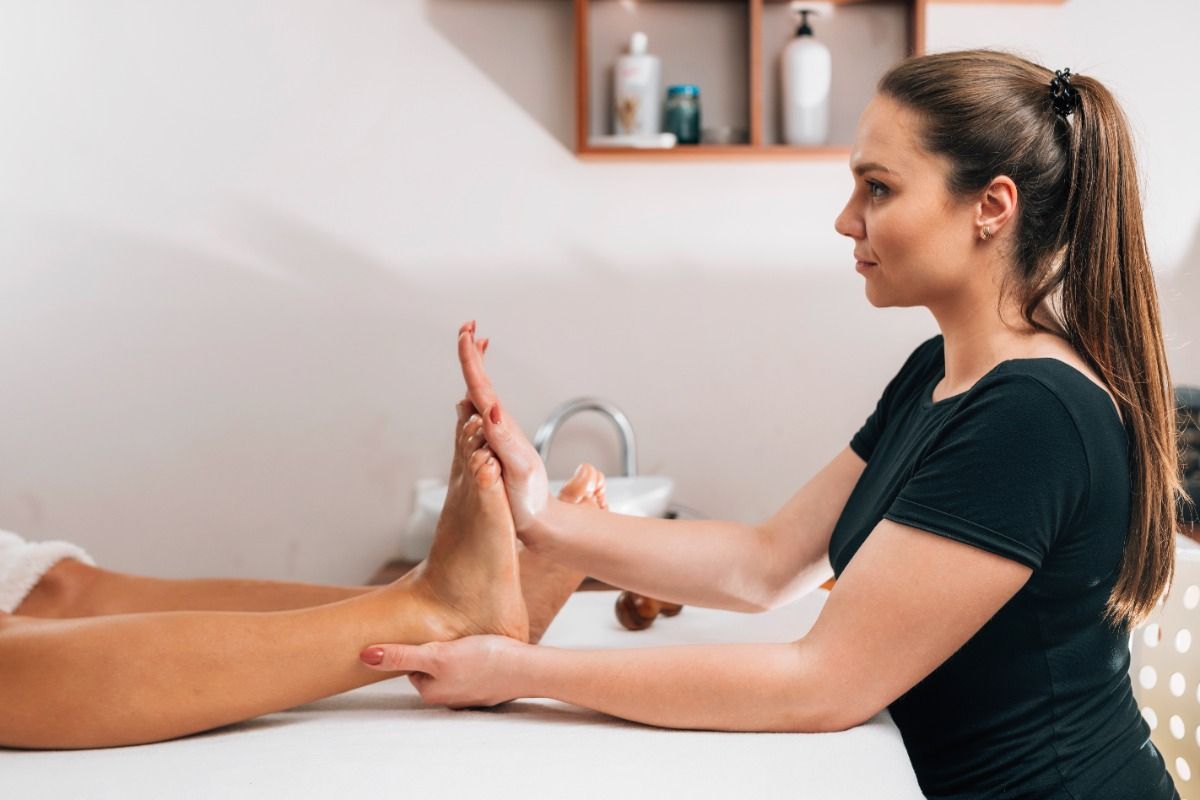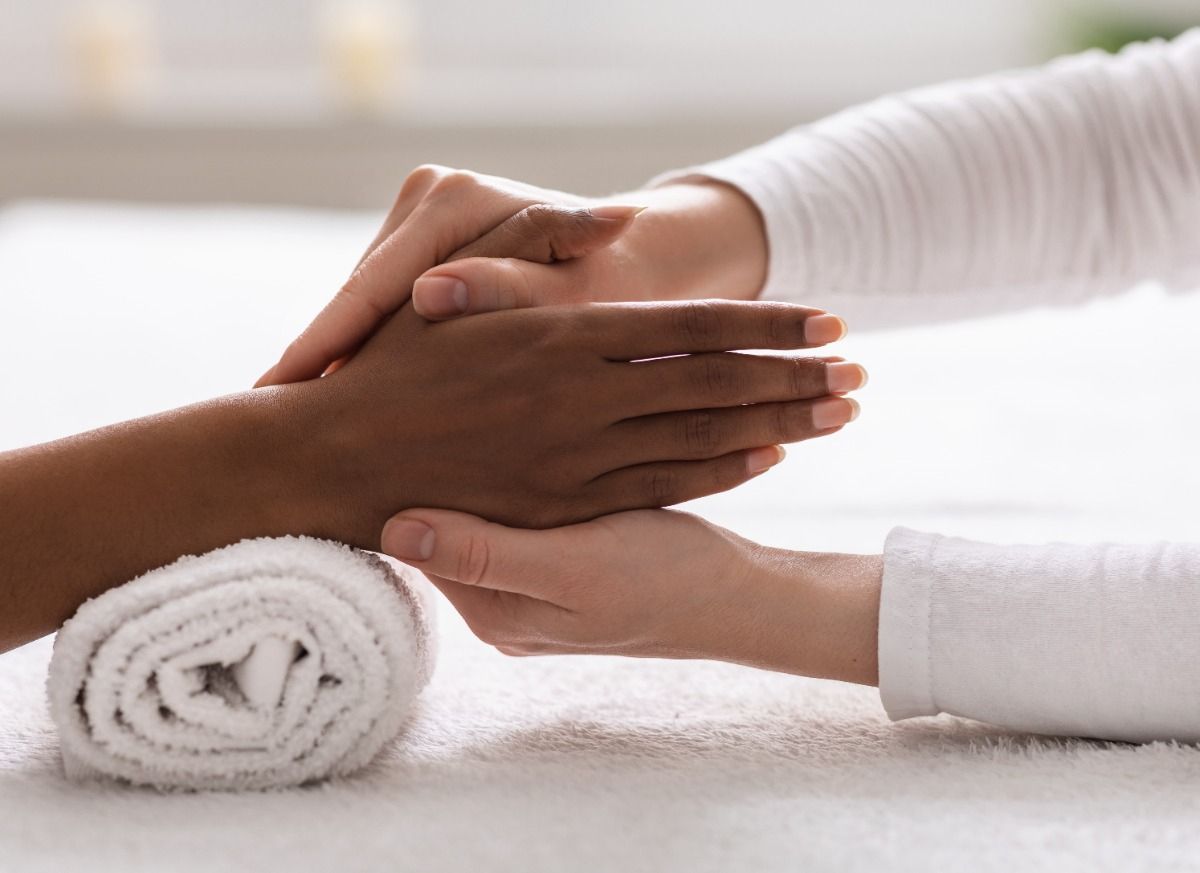
Reflexology is a form of massage therapy also known as zone therapy that involves applying pressure to specific pressure points on the feet and/or hands. Reflexology is considered alternative medicine, and many people believe that certain areas of the feet are connected to specific parts of the body or internal organs.
Reflexology aims to relieve aches, pains, and stress through certain pressure points. It is a type of massage that is strategic in its application of pressure to areas of the feet, hands, and even the ears because these areas outside the body supposedly connect to specific internal organs.
A person who practices this technique is called a reflexologist, relying on foot and hand charts (zones) to guide them in the application of pressure. When a specialist relieves stress in your body through reflexology, you can enjoy a wide array of health benefits and experience improvement in overall well-being.
As an added bonus, a foot or hand massage also feels great for the most part. Certain areas may hurt when pressure is applied, but you’re meant to power through for the health benefits.
The reason the practice of reflexology is alternatively referred to as zone therapy is because it targets specific zones or areas for relief. Find out more about reflexology below, to understand how it works and assess if it’s worth it for you to give this ancient therapy a try.
How Reflexology Works
Today, scientists continue to study reflexology because it is a fascinating field that can complement Western medicine. The practice has long been ingrained in alternative medicine, in particular, traditional Chinese medicine.
Chinese medicine believes that different body parts correspond with various pressure points.
For example, the webbing between the thumb and pointer finger is a pressure point that could help relieve headaches. These pressure points are mapped all over the head, limbs, feet, hands, and ears. It is believed that by pressing into these pressure points, the body is reconnected to its optimal energy level and energy flows are directed towards the areas in need of healing.
Other theories point towards the relief coming from the connection between skin and internal organs, or the connection between the external and internal factors. This belief espouses that reflexology pinpoints the central nervous system promoting relaxation.
Another theory is that reflexology efficacy is directly related to zonal points. This theory rests on the 10 vertical zones of the body that contain different sets of body parts corresponding to specific fingers and toes. Pressing these specific areas is considered to bring healing to the body parts they are linked to. To illustrate, the pressure points in reflexology include:
- The tip of the pinky is the pressure point affecting the heart.
- The point of the middle finger directly below the nail bed is related to blood pressure and the same area of the index finger is associated with toothache relief.
- The webbing between all four fingers, excluding the thumb, is for lymph glands.
- The webbing between the thumb is believed to bring ease to pain in the head, eyes, neck, throat, shoulder, and chest, and relieve migraines and colds.
- The Achilles heel area eases the sciatic nerves.
- Massaging the heels of the feet can relieve lower back or gluteal pain.
- Applying pressure to the outside parts of the feet can relieve knee, leg, elbow, arm, and shoulder pain.
- On the inside of the feet, massaging the arch of the foot helps with bladder problems.

Why Do People Believe in Reflexology and Seek It Out?
Since reflexology could potentially reduce pain, alleviate stress, promote good sleep, and help with anxiety, many people seek it out as a form of therapy. When you analyze it, applying pressure by massaging areas of the feet or hands is a very low risk and very reasonable option if you’re seeking stress relief or want to achieve relaxation. Below are some common reasons why people seek this treatment:
1. Reflexology is an ancient tradition
As previously mentioned, reflexology is a long-standing tradition that has worked for many cultures. This, in part, is why some associate this therapy to be a great source of healing. Its long history with ancient medicine, along with many happy patients, proves that reflexology could provide relief for certain issues.
2. It’s a natural alternative to traditional western medicine
For individuals already overloading their kidneys and liver with pharmaceutical medication, like chronically ill patients, reflexology is one way to seek treatment without taxing the internal organs further. Moreover, one can learn to practice reflexology safely at home with all the online resources available, making it a more cost-efficient option for some.
3. Can be used in conjunction with other treatments
Reflexology could be seen as a corollary treatment for certain conditions. For example, apart from just taking pain medication for extreme migraine or neck and back pain, you could rely on reflexology to abate symptoms. Most of the time, patients combine reflexology with other hand-son therapies like those who need physical therapy, occupational therapy, inversion therapy, or chiropractic help.
4. Provides an effective placebo
Modern scientists are still trying to understand reflexology, as, historically, the practice was built on redirecting energy to areas that are in need of it. In that regard, reflexology may serve as a placebo effect to ease daily anxiety, stress, and tension. And with its low-cost and very minimal side-effects, you have little to lose in seeking this kind of treatment.
In other words, getting reflexology won’t hurt you, even if it doesn’t work. We overuse our feet and hands, and it’s nice to get them massaged and attended to.

The Benefits of Reflexology
Many assert that reflexology can provide a multitude of benefits. The benefits of reflexology include pain relief, relaxation benefits, nerve stimulation, improved energy levels, improved blood circulation, relieve tight muscles or tendons, and more.
Many people need more blood flow to their feet, and a reflexology foot massage can certainly help with this.
Who Can Benefit Most From Reflexology?
Reflexology works with different pressure zones that target different areas of the body and heal certain areas. The bottom line is, anyone can get this form of therapy. Reflexology can be used to resolve not only back, feet, and head pain, but it is also great for addressing sinus issues.
However, some people are recommended to seek reflexology more than others. Individuals who are advised to seek reflexology as an alternative source of healing are those with the following conditions:
- Those with stress management issues
- People with anxiety disorders
- Those suffering with arthritis pain
- Individuals with chronic neck, back, and foot pain
- People with digestive issues
- Chronic migraine sufferers
- Those with sinus issues
- People with sleep disorders
- People with foot pain
- Those who have trouble walking due to poor blood circulation
Why Reflexology is Commonly Used For Foot Pain
One of the most common areas for reflexology treatments is the feet. This is because many people spend hours standing, walking a lot, or exercise daily with the feet bearing the majority of their weight every single day. This causes most of the external and internal pressure to fall down to the feet.
Thus, reflexology is often used as a treatment for different foot issues such as tendonitis and plantar fasciitis. Achilles Tendonitis can be caused by a sudden injury, however, it is often linked to repetitive movement over an extended period of time. Plantar fasciitis is attributed to a throng of reasons, like a poor choice of shoes, the inherent structure of the feet, or being overweight.
Deep tissue massage involving certain pressure points in the feet is suggested to be beneficial for patients dealing with Achilles Tendonitis and Plantar Fasciitis. The effects of such treatment may be amplified through the concomitant use of essential oils and other herbal medicine during the reflexology massage.
On top of that, reflexology could help ease overall foot or heel pain. Often, sore feet or pain in any region of the foot is caused by too much pressure on the feet all day. This can be due to genetics such as from being flat-footed. Or from engaging in exercise or activities without the proper footwear designed to provide you with the appropriate foot support. Furthermore, pain could also be attributed to wearing the wrong size shoes, worn-out shoes, shoes without insoles, or not stretching the muscles and ligaments of the feet and achilles before engaging in strenuous exercises.
Keep in mind that reflexology is just one of many possible ways to manage your pain, alleviate your stress, and regulate your nervous system.
If you want to take a closer look at your genetic health risks, your genetic risk of achilles injury, disease risk, and other health insights, consider taking a CircleDNA test. This at-home DNA testing kit is the world’s most comprehensive DNA test. It will provide you with over 500 reports containing information about yourself based on your unique DNA.






